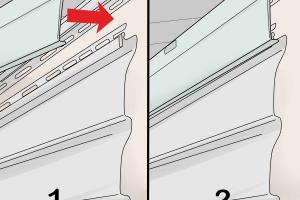Ultimate Guide to Installing Aluminum Siding: A Step-by-Step Approach

-
Quick Links:
- Introduction
- Benefits of Aluminum Siding
- Tools and Materials Needed
- Preparation Steps
- Installation Steps
- Finishing Touches
- Maintenance of Aluminum Siding
- Case Studies
- Expert Insights
- FAQs
Introduction
Installing aluminum siding is an excellent way to enhance the aesthetic appeal and durability of your home. With its lightweight yet sturdy nature, aluminum siding offers a reliable solution for homeowners looking to upgrade their exterior. This guide provides a comprehensive, step-by-step approach to installing aluminum siding, making it accessible even for DIY enthusiasts.
Benefits of Aluminum Siding
Aluminum siding comes with several advantages:
- Durability: Aluminum siding is resistant to many elements, including moisture and pests.
- Low Maintenance: It requires minimal upkeep compared to other siding materials.
- Variety of Styles: Available in various colors and finishes, aluminum siding enhances the curb appeal of any home.
- Energy Efficiency: Properly installed aluminum siding can improve insulation, leading to reduced energy costs.
- Environmentally Friendly: Aluminum can be recycled, making it a sustainable choice.
Tools and Materials Needed
Before you begin the installation process, gather the necessary tools and materials:
- Aluminum siding panels
- Starter strip
- J-channel trim
- Utility knife
- Measuring tape
- Level
- Hammer and nails (or a siding nail gun)
- Caulk and caulking gun
- Safety goggles and gloves
Preparation Steps
Proper preparation is essential for a successful installation:
- Inspect the Existing Surface: Ensure that the surface is clean, dry, and free from rot or damage.
- Measure Your Walls: Accurate measurements will help determine the amount of siding needed.
- Choose Your Siding Style: Decide on the finish and color that best suits your home.
- Gather Necessary Permits: Check local building codes to see if permits are required.
Installation Steps
Follow these detailed steps for a successful installation:
Step 1: Install the Starter Strip
The starter strip creates a secure base for the first row of siding. Here’s how to install it:
- Position the starter strip along the bottom of the wall, ensuring it is level.
- Nail it to the wall, leaving a small gap for expansion.
Step 2: Install the J-Channel Trim
The J-channel trim is crucial for framing windows and doors:
- Cut the J-channel to fit around windows and doors.
- Attach the J-channel to the wall using nails, ensuring that it is level.
Step 3: Hang the First Panel
Now that your starter strip and J-channel are in place, it’s time to hang the first panel:
- Align the first panel with the starter strip and J-channel.
- Secure it in place with nails, ensuring that the panel can expand and contract.
Step 4: Continue Installing Panels
Repeat the process for subsequent panels:
- Overlap each panel according to the manufacturer’s instructions.
- Ensure each panel is level and secure.
Step 5: Cut Panels for Corners and Edges
Use your utility knife to cut panels as needed to fit corners and edges:
- Measure carefully before cutting to avoid waste.
- Secure the cut panels in place, ensuring a tight fit.
Finishing Touches
Once all panels are installed, it’s time for the finishing touches:
- Fill any gaps with caulk to prevent water infiltration.
- Inspect the entire installation for any loose panels or nails.
- Clean the siding to remove any debris or fingerprints.
Maintenance of Aluminum Siding
To keep your aluminum siding looking great:
- Wash it with soap and water at least once a year.
- Inspect for scratches or dents and repair as needed.
- Check for any loose panels or fasteners regularly.
Case Studies
Here are a few examples of successful aluminum siding installations:
Case Study 1: The Smith Family Home
The Smith family upgraded their home with aluminum siding to improve energy efficiency. Post-installation surveys showed a 20% reduction in energy costs.
Case Study 2: Eco-Friendly Renovation
A local contractor installed aluminum siding on a historic home, preserving its charm while significantly enhancing its structural integrity. The project received accolades for its sustainability.
Expert Insights
We spoke with several home improvement experts regarding aluminum siding:
"Aluminum siding is a fantastic choice for homeowners looking for durability and low maintenance without sacrificing aesthetics." - John Doe, Home Renovation Specialist.
FAQs
1. How long does aluminum siding last?
Aluminum siding can last upwards of 30 years with proper maintenance.
2. Can I install aluminum siding over existing siding?
Yes, but it’s recommended to remove the old siding for the best results.
3. Is aluminum siding energy efficient?
Yes, it can improve insulation when installed correctly, leading to lower energy bills.
4. How do I clean aluminum siding?
Use a mixture of soap and water, and avoid harsh chemicals that can damage the finish.
5. What colors does aluminum siding come in?
Aluminum siding is available in a variety of colors and finishes, including painted and coated options.
6. Is aluminum siding prone to denting?
While it can dent, modern aluminum siding is more resilient than older versions.
7. Can I paint aluminum siding?
Yes, but it’s essential to use the right type of paint and primer designed for metal surfaces.
8. How does aluminum siding compare to vinyl siding?
Aluminum is generally more durable than vinyl, but vinyl offers a broader range of colors and finishes.
9. What is the cost of installing aluminum siding?
The cost can vary widely based on location, siding quality, and installation complexity, typically ranging from $3 to $7 per square foot.
10. Do I need professional help to install aluminum siding?
While DIY installation is possible, hiring a professional ensures a higher quality finish and potentially saves time.
Random Reads